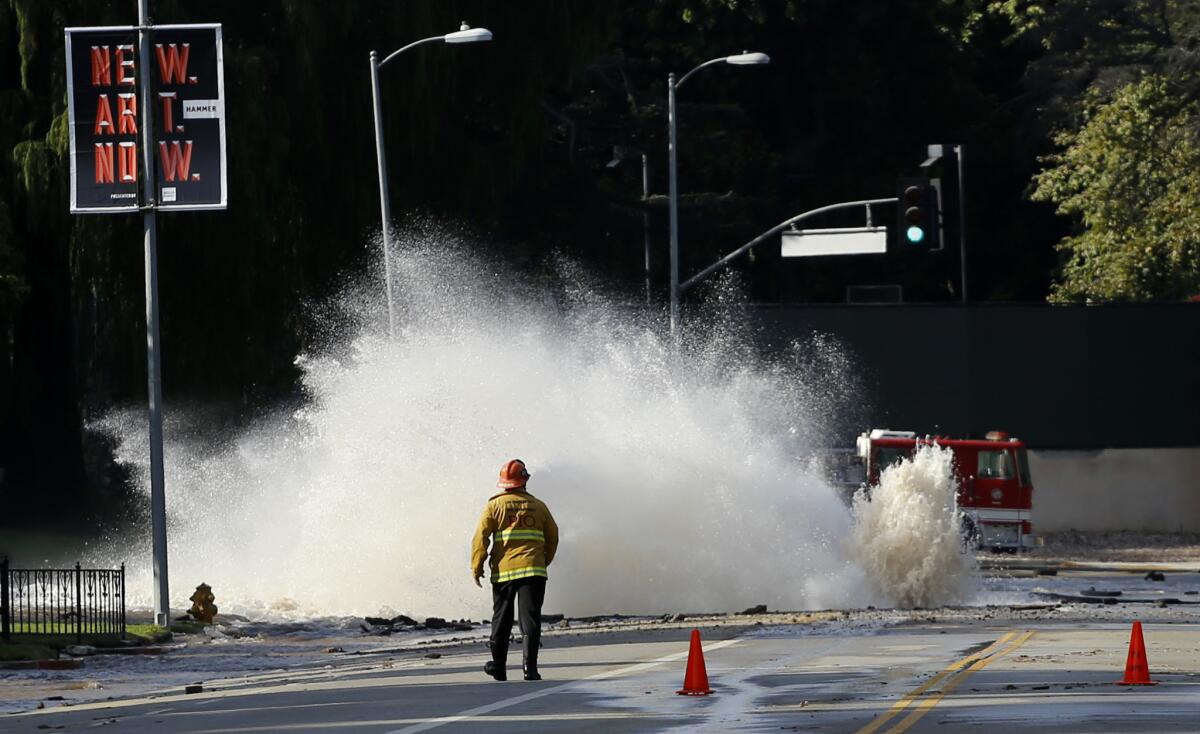DWP takes first step toward possible rate increases

Water gushes from a broken pipe on Sunset Boulevard near UCLA in July 2014, flooding portions of the campus.
- Share via
The Los Angeles Department of Water and Power took a first step Tuesday toward possible rate increases as it tries to address aging infrastructure that has resulted in spectacular water pipe breaks and other problems.
The Board of Water and Power Commissioners ordered up a plan examining how the nation’s largest municipal utility can generate millions of dollars in new revenue.
A new analysis presented Tuesday estimated that the DWP will need $270 million in additional revenue in each of the next five years. Much of the money is needed to replace aging water pipes and to pay for costs connected to meeting environmental regulations.
Last year’s massive pipe break on Sunset Boulevard, which flooded portions of the UCLA campus, caused millions of dollars in damage and became a vivid symbol of the agency’s crumbling infrastructure.
A Times analysis found that about one-fifth of the city’s water pipes were installed before 1931 and nearly all will reach the end of their useful lives in the next 15 years. The DWP has a $1.3-billion plan to replace 435 miles of deteriorating pipe in the next 10 years, The Times reported.
With a 3-1 vote, the board instructed DWP staff to draw up a plan within 30 days that officials say will include water and power rate proposals that could help pay for new pipes.
But in the wake of a customer billing scandal and continued fallout from an audit that found “cavalier” spending of more than $40 million of ratepayer money, any request by the beleaguered utility to raise rates could prove a tough sell.
“You get into the whole trust factor here. Do you trust DWP?” said Jack Humphreville, a member of the Greater Wilshire Neighborhood Council who writes about the DWP for the website CityWatch. “I don’t have any question that DWP needs money. The gripe you have is that you want to make sure your getting bang for your buck.”
DWP spokesman Joe Ramallo said the department has already saved hundreds of millions of dollars in recent years thanks to a hiring freeze, a new labor contract, low-interest borrowing and other cost-cutting measures. “We’re always looking for ways to make our customers’ money go further,” he said.
There have been no base rate increases for water since a one-time 3.1% hike in 2009, Ramallo added. The last base rate increase for power came in 2012, when an 11% increase was spread over two years.
It’s not clear how big an increase officials will ask for this time. The proposal due back to the board in June will explain what the revenue requirements “translate to for our customers in terms of their bills and their rates,” Ramallo said.
The forecast presented Tuesday calls for $90 million in additional annual revenue for water and $180 million for power until fiscal year 2019-20. This year, DWP’s overall revenue will total about $4.7 billion, Ramallo said.
After DWP staff presents its initial proposal, neighborhood councils and the city’s ratepayer advocate will have at least four months to weigh in before the board can formally review and approve it. Both the council and the mayor must approve a rate proposal before it takes effect.
Mayor Eric Garcetti pledged not to hike utility rates in 2014, saying the DWP needed to first rebuild trust with its customers. “Like the average ratepayer, I will have to be shown the case,” he said earlier this year.
“The DWP has a significant need to invest in its water and power infrastructure and meet state mandates,” said Jeff Millman, Garcetti’s spokesman. “Our office will review DWP’s revenue proposals that they will present in the coming weeks to address those needs.”
City ratepayer advocate Fred Pickel said the revenue information presented Tuesday is likely to change, in part because DWP staff will have more updated budget information. The review process is likely to produce further changes.
Still, Pickel said many other major utilities conduct rate reviews once every three years.
“The ratepayer advocate strongly supports beginning a rate review,” he said. “It’s important we walk through this analysis in a transparent way.”
Twitter: @bymattstevens
More to Read
Sign up for Essential California
The most important California stories and recommendations in your inbox every morning.
You may occasionally receive promotional content from the Los Angeles Times.














